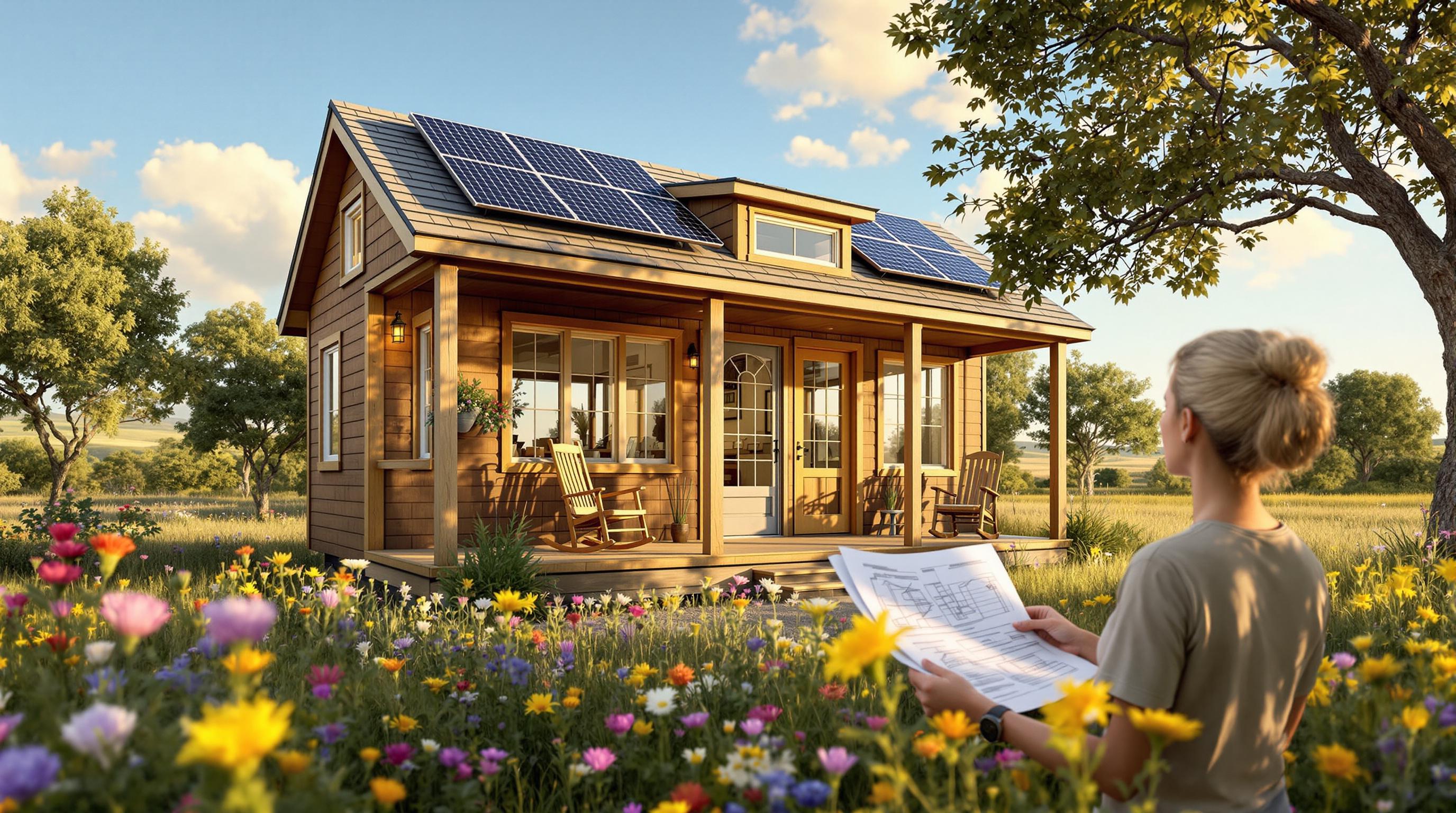Protect your tiny home's pipes from freezing this winter with these 5 key insulation tips:
- Use heat tape on exposed pipes
- Add foam insulation to all pipes
- Install house skirting to block cold air
- Insulate indoor pipes, especially near exterior walls
- Protect underground pipes below the frost line
Why it matters:
- Prevents burst pipes and water damage
- Keeps water flowing in freezing temps
- Saves energy and lowers heating costs
At-risk pipes to focus on:
- Exposed exterior pipes
- Pipes in unheated spaces
- Pipes in exterior walls
- Where pipes enter the house
| Insulation Type | R-value | Cost | Best For |
|---|---|---|---|
| Spray foam | High | $$$ | Hard-to-reach areas |
| Fiberglass | Medium | $ | General use |
| Foam tubes | Medium | $ | DIY, budget-friendly |
| Rubber | Medium | $$ | Temperature swings |
Key steps:
- Clean pipes
- Measure and cut insulation
- Apply heat tape if needed
- Install insulation sleeves
- Insulate joints/valves
- Seal any gaps
Be prepared:
- Have backup heat sources ready
- Know how to safely thaw frozen pipes
- Keep emergency supplies on hand
Insulating your tiny house pipes is crucial for avoiding costly damage and staying comfortable all winter long. A little prep work now can save major headaches later.
Related video from YouTube
Benefits of Pipe Insulation
Pipe insulation isn't optional in tiny houses - it's a must-have. Here's why:
It stops pipes from bursting. When water freezes, it expands. In pipes, this can cause cracks or full-on bursts. Insulation keeps pipes above freezing, saving you from expensive repairs.
It keeps your water flowing. No one wants to wake up to dry taps. Insulation makes sure your plumbing works, even when it's freezing outside.
It saves energy. Insulated pipes hold onto heat better. This means your water heater doesn't have to work as hard, cutting down on energy use.
Winter Pipe Problems
Tiny house owners face some unique hurdles when it comes to protecting pipes in winter:
Space is tight. Every inch counts in a tiny house, so finding room for insulation can be tricky.
Pipes are often exposed. Many tiny houses have more exposed pipes than regular homes, making them more likely to freeze.
Temperatures change fast. Smaller spaces heat up and cool down quicker, which can stress out plumbing systems.
Here's a quick look at common winter pipe issues and how they hit tiny houses:
| Issue | Impact on Tiny Houses |
|---|---|
| Frozen pipes | Can cause bursts, leading to water damage in small spaces |
| Slow water flow | More noticeable in tiny plumbing systems |
| Higher energy bills | Hits harder on tight tiny house budgets |
"In a tiny house, a little preparation goes a long way. Insulating your pipes isn't just about comfort - it's about protecting your entire home." - Jay Shafer, Four Lights Tiny House Company
Bottom line? When it comes to tiny house pipes in winter, prevention is key. A little insulation now can save you from big headaches later.
Finding At-Risk Pipes
In a tiny house, every pipe counts. Knowing which ones might freeze can save you from a winter nightmare. Let's look at how to spot these weak spots and check their temps before things go south.
Where Pipes Freeze Most
Tiny houses have their own pipe-freezing problems. Here are the danger zones:
- Exposed pipes: Your biggest worry. If you can see it, it's at risk.
- Exterior walls: Pipes here often lack good insulation.
- Unheated spaces: Think storage lofts or under-floor areas.
- Entry points: Where pipes come into your house, cold air can sneak in.
| Location | Risk | Why It's Risky |
|---|---|---|
| Exposed pipes | High | Cold air hits them directly |
| Exterior walls | High | Not much insulation |
| Unheated spaces | Medium | No heat control |
| Entry points | Medium | Drafts can get in |
In a tiny house, pipes can freeze around 0°C if they're not protected. In Canada, watch out when it hits -4°C or lower.
Checking Pipe Temperature
Catch a freezing pipe early and save yourself a headache. Here's how:
1. Look for frost: See ice on exposed pipes? That's bad news.
2. Touch test: Carefully feel the pipes for cold spots. But be careful - very cold pipes can hurt your skin.
3. Check water flow: Turn on your faucets. If the flow's weak, a pipe might be freezing.
4. Listen up: Hear banging or clanking when you run water? Could be freezing pipes.
5. Use a thermometer: Want to be sure? An infrared thermometer can tell you exactly how cold a pipe is.
"Frost on pipes is a dead giveaway for freezing." - WaterSmart
Pro Tip: Make a checklist of all the risky spots in your tiny house. Check them often when it's cold out.
sbb-itb-2ef3f3a
5 Ways to Insulate Pipes
Keeping your tiny house pipes from freezing in winter is a must. Here are five effective ways to insulate your pipes:
Using Heat Tape
Heat tape is a top choice for tiny house pipe insulation. It's flexible, easy to install, and works on most pipe types.
To use heat tape:
- Clean the pipe surface
- Wrap the tape from the lowest point, overlapping slightly
- Don't compress the tape - it works best when puffy
- Connect to a temperature control device for safety
"I recommend this Heat Cable with Built-in Thermostat and 12 Feet of High-Temp Installation Tape by Radiant Solutions." - TinyHome.io expert
Safety note: Keep heat tape at least 13 mm from flammable materials to prevent fires.
Adding Foam Insulation
Foam insulation is cheap and easy to install - perfect for DIY tiny house owners.
Foam insulation types:
| Type | Pros | Cons |
|---|---|---|
| Polyethylene foam | High R-value, easy install | Less durable |
| Rubber insulation | Adapts to temp changes | Pricier |
| Spray foam | Great for tight spots | Can off-gas VOCs |
To install foam insulation:
- Pick pre-cut foam tubes for easy use
- Slip the foam over the pipe
- Secure with tape every foot
Pro tip: For plastic pipes, wrap them in aluminum foil before adding foam to spread heat evenly.
Adding House Skirting
Skirting your tiny house can stop pipes from freezing and cut heating costs.
Skirting benefits:
- Blocks cold air
- Protects under-house pipes
- Boosts energy efficiency
Make sure to seal the skirting properly for best results.
Protecting Indoor Pipes
Don't forget about pipes inside your tiny house. They're at risk too, especially in cabinets and near outside walls.
To protect indoor pipes:
- Open cabinet doors to let warm air in
- Use foam insulation on pipes in cold areas
- Try ROXUL insulation for walls and ceilings
"Cover all tops, bottoms, and corners of the interior framing, windows, and doors." - Marc Bilodeau, Author at TinyHome.io
Underground Pipe Protection
For tiny houses with underground plumbing, good insulation is key.
To insulate underground pipes:
- Find your area's frost line depth
- Insulate pipes below this depth
- Use high-density, closed-cell foam for water resistance
- Add a layer of gravel around pipes for extra protection
Choosing Insulation Materials
Picking the right insulation for your tiny house pipes can make or break your winter prep. Let's break down the top options:
| Material | R-value | Cost | Strength | Ease of Setup | Best For |
|---|---|---|---|---|---|
| Spray Foam | High (6.25 per inch) | $$$$ | Excellent | Professional | Air sealing, hard-to-reach areas |
| Fiberglass | Moderate | $ | Good | DIY-friendly | General use, fire resistance |
| Polyethylene Foam | Moderate | $ | Good | Very easy | DIY, budget-conscious |
| Rubber | Moderate | $$ | Excellent | Easy | Temperature fluctuations |
| Mineral Wool | High | $$$ | Excellent | Moderate | Fire resistance, noise reduction |
Spray Foam: The heavyweight champ of insulation. It's got the highest R-value and seals air leaks like a pro. But it'll cost you - up to six times more than fiberglass. Plus, you'll need to call in the pros to install it.
"Spray foam can nearly double the hurricane resistance of older roofs." - Building Science Corporation
Fiberglass: The old reliable. It's cheap, it's fire-resistant, and you can DIY it. Just don't forget the vapor barrier, or you'll be dealing with a soggy mess.
Polyethylene Foam: Think pool noodles for your pipes. It's cheap, it's easy, and you can do it yourself. Six feet for under $10? That's a steal.
Rubber Insulation: The all-rounder. It handles temperature swings like a champ and works inside and out. Perfect for keeping those pipes frost-free in your tiny house.
Mineral Wool: The tough guy. It costs a bit more, but it can take the heat - up to 1,000°F. Great for fire resistance and keeping things quiet.
When you're picking insulation, keep these in mind:
- R-value: Higher means better insulation.
- Cost: Balance your budget with what you need.
- DIY or pro: Can you install it yourself, or do you need to call in the experts?
- Special needs: Think about fire resistance, noise, and moisture control.
Pick the right insulation, and you'll keep those pipes cozy all winter long.
How to Install Insulation
Let's talk about insulating pipes in your tiny house. It's a big deal for keeping your plumbing safe when it gets cold. Here's how to do it right.
Getting Ready
First things first. You'll need some stuff:
| Tools | Materials |
|---|---|
| Utility knife | Pipe insulation sleeves |
| Measuring tape | Heat tape |
| Duct tape | Zip ties |
| Cleaning rags | Gentle cleanser |
| Caulk gun | Caulk |
Installation Steps
Here's how to insulate those pipes:
1. Clean the pipes
Grab a rag and some gentle cleaner. Wipe down those pipes and let them dry.
2. Measure and cut
Figure out how long and wide your pipes are. Cut your insulation to fit, but leave a bit extra for overlap.
3. Apply heat tape (if needed)
If you live somewhere that gets REALLY cold:
- Start at the bottom of the pipe
- Wrap the tape around, overlapping a bit
- Hook it up to a temperature control gizmo
"Heat tape's great for super cold places. Just keep it away from anything that can catch fire." - Bob Vila
4. Install insulation sleeves
- Slide the insulation over the pipe
- Seal it up with the sticky strip or duct tape
- Use zip ties every foot to keep it snug
5. Insulate joints and valves
Cut small pieces of insulation for joints and valves. Duct tape them in place.
6. Seal gaps
Use caulk to fill any holes where cold air might sneak in and hit your pipes.
Testing Your Work
After you're done, make sure it's working:
- Look for any spots you missed or loose areas.
- On a cold day, feel the pipes for cold spots.
- See if your hot water stays hot longer now.
- Check if your energy bills go down.
Don't forget to check your insulation once a year. If you see any wear and tear, fix it up to keep your pipes protected.
Preparing for Problems
Even the best-insulated tiny house can face plumbing challenges in winter. Here's how to stay one step ahead:
Backup Heat Sources
When the mercury drops, a Plan B for heating can be a pipe-saver. Let's look at some options:
| Backup Heat Source | Pros | Cons |
|---|---|---|
| Mr. Buddy Portable Heater | Heats 200 sq ft, indoor-safe, safety features | Needs propane, limited coverage |
| Space heaters | Portable, electric-powered | Can overload electrical systems, fire risk |
| Heat lamps | Focused heat for trouble spots | Limited coverage, potential fire hazard |
"We got a Mr Buddy Portable Heater. It heats up to 200 square feet with propane, is safe indoors, and has oxygen sensors and tip-over auto shut-offs." - TinyHome.io expert
Safety first, always. Follow the manual and never leave portable heaters alone.
Unfreezing Pipes Safely
Woke up to frozen pipes? Don't sweat it. Here's the game plan:
1. Turn off the main water valve to stop potential flooding.
2. Open the faucet connected to the frozen pipe to ease pressure.
3. Apply heat to the frozen section:
- Use a hairdryer, starting near the faucet and working back
- Wrap pipes with heating pads or warm towels
- Set up space heaters nearby (keep them away from anything that can catch fire)
"If a pipe bursts before you can thaw it, shut off your home's water immediately." - Applewood Plumbing Experts
Don't ever use an open flame to thaw pipes. It's asking for trouble and can wreck your plumbing.
Emergency Supply List
Stock up on these must-haves:
- Heat tape
- Pipe insulation sleeves
- Portable space heater
- Hairdryer
- Towels
- Bucket (for leaks)
- Plumber's number
Stash a mini emergency kit in each room for quick access. This prep can be the difference between a minor hiccup and a major headache.
If a pipe does burst, time is money. The average water damage claim runs $10,000 to $20,000. Knowing where your main water shut-off valve is can save you big bucks.
"Everyone should know where it is [the main water shut-off valve]. The faster you can shut off the water, the less it'll cost you." - Paul Abrams, Roto-Rooter spokesman
Wrap-Up
Winterizing your tiny house's plumbing is a must to avoid expensive damage and stay cozy when it's cold outside. Here's a quick rundown of how to keep those pipes safe:
Insulation is your best friend. Wrap exposed pipes with foam sleeves, especially in cold spots like basements and attics. It's cheap too - only 50 cents per foot.
Keep the heat on. Set your thermostat to at least 55°F, even when you're not home. This helps warm the air around your pipes.
Let faucets drip in freezing weather. It keeps water moving and eases pressure in the pipes.
Seal up gaps. Use caulk or weather-stripping to block cold air from sneaking in. And if you've got pipes in the garage, keep that door shut.
Be ready for anything. Have heat tape, portable heaters, and extra insulation on hand. Know where to find your main water shut-off valve.
As plumbing expert Richard Trethewey puts it:
"Taking proactive steps to protect your pipes from freezing saves you considerable money and stress in the long run."
Smart move. A little work now means less hassle (and cash) later.



